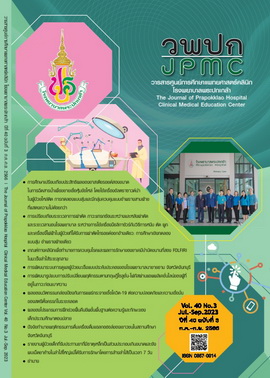Comparison of the Effectiveness of Two Corticosteroid Dosages in Ultrasound-guided Capsular Hydrodilatation in Patients with Adhesive Capsulitis: A Randomized, Triple-blind, Non-inferiority Study
Main Article Content
Abstract
BACKGROUND: Hydrodilatation is one of the common treatments for adhesive capsulitis (AC) and aims to achieve physical distension of the shoulder joint capsule by injecting a considerable amount of fluid that contains normal saline, corticosteroids, and local anesthetics into the joint. The dosage of triamcinolone acetonide (TA) commonly used in hydrodilatation fluid is 20-40 mg. Intra-articular corticosteroids have many potential complications.
OBJECTIVES: To compare the effectiveness of two corticosteroid dosages (10 mg VS 40 mg TA) in ultrasound-guided capsular hydrodilatation in patients with AC
METHODS: A randomized, triple-blind, non-inferiority study. Forty-two participants who had been diagnosed with AC were randomly divided into 2 groups. Both groups received ultrasound-guided hydrodilatation. Hydrodilatation fluid in the 10 mg TA group contained 1 mL of 10 mg TA, 5 mL of 1% lidocaine, and 14 mL of normal saline solution, while in the 40 mg TA group contained 1 mL of 40 mg TA, 5 mL of 1% lidocaine, and 14 mL of normal saline solution. Outcome measures include the Shoulder Pain and Disability Index (SPADI) as primary outcome, passive range of motion, and visual analogue scale at 4 weeks.
RESULTS: The mean SPADI at 4 weeks were 27.5±12 in 10 mg TA group and 24.5±13 in 40 mg TA group. The upper bound of the 95% CI of 10 mg group (33.0) lay below the lower bound of the 95% CI of 40 mg TA group (18.6) plus non-inferiority margin of 15 (33.6). There was also no significant difference between the two groups at 4 weeks for all secondary outcome measurements except passive external rotation of the shoulder.
CONCLUSIONS: Using 10 mg of TA in hydrodilatation fluid was similar to using 40 mg of TA in terms of function improvement in patients with stage 2 and 3 of AC. For patients with AC, hydrodilatation with a low dose of corticosteroids may be the optimal treatment option.
Thaiclinicaltrials.org number, TCTR20201125003
Article Details

This work is licensed under a Creative Commons Attribution-NonCommercial-NoDerivatives 4.0 International License.
References
Finnoff JT. Upper limb pain and dysfunction. In: Cifu DX, Editor. Braddom’s physical medicine & rehabilitation. 5th ed. Philadelphia: Elsevier; 2016. P.774-5.
Hand C, Clipsham K, Rees JL, Carr AJ. Long-term outcome of frozen shoulder. J Shoulder Elbow Surg 2008;17:231-6.
Lin MT, Hsiao MY, Tu YK, Wang TG. Comparative efficacy of intra-articular steroid injection and distension in patients with frozen shoulder: a systematic review and network meta-analysis. Arch Phys Med Rehabil 2018;99:1383-94.e6.
Wu WT, Chang KV, Han DS, Chang CH, Yang FS, Lin CP. Effectiveness of glenohumeral joint dilatation for treatment of frozen shoulder: a systematic review and meta-analysis of randomized controlled trials. Sci Rep [Internet].2017[cited 2020 July 14];7(1):10507. Available from: https://www.ncbi.nlm.nih.gov/pmc/articles/PMC5585252/pdf/41598_2017_Article_10895.pdf
Catapano M, Mittal N, Adamich J, Kumbhare D, Sangha H. Hydrodilatation with corticosteroid for the treatment of adhesive capsulitis: a systematic review. PM R 2018; 10:623-35.
Buchbinder R, Green S, Forbes A, Hall S, Lawler G. Arthrographic joint distension with saline and steroid improves function and reduces pain in patients with painful stiff shoulder: results of a randomised, double blind, placebo controlled trial. Ann Rheum Dis 2004;63:302-9.
Kim K, Lee KJ, Kim HC, Lee KJ, Kim DK, Chung SG. Capsule preservation improves short-term outcome of hydraulic distension in painful stiff shoulder. J Orthop Res 2011;29:1688-94.
de Jong BA, Dahmen R, Hogeweg JA, Marti RK. Intra-articular triamcinolone acetonide injection in patients with capsulitis of the shoulder: a comparative study of two dose regimens. Clin Rehabil 1998;12:211-5.
Yoon SH, Lee HY, Lee HJ, Kwack KS. Optimal dose of intra-articular corticosteroids for adhesive capsulitis. Am J Sports Med 2013;41:1133-9.
Habib GS. Systemic effects of intra-articular corticosteroids. Clin Rheumatol 2009;28:749-56.
Jacobs JWG, Michels-van Amelsfort JMR. How to perform local soft-tissue glucocorticoid injections?. Best Pract Res Clin Rheumatol 2013;27:171-94.
Nakazawa F, Matsuno H, Yudoh K, Watanabe Y, Katayama R, Kimura T. Corticosteroid treatment induces chondrocyte apoptosis in an experimental arthritis model and in chondrocyte cultures. Clin Exp Rheumatol 2002;20:773-81.
Fubini SL, Todhunter RJ, Burton-Wurster N, Vernier-Singer M, MacLeod JN. Corticosteroids alter the differentiated phenotype of articular chondrocytes. J Orthop Res 2001;19:688-95.
Wernecke C, Braun HJ, Dragoo JL. The effect of intra-articular corticosteroids on articular cartilage. Orthop J Sports Med [Internet].2015[cited 2020 Aug 25];3(5):2325967115581163. Available from: https://journals.sagepub.com/doi/10.1177/2325967115581163?url_ver=Z39.88-2003&rfr_id=ori:rid:crossref.org&rfr_dat=cr_pub%20%200pubmed
Ekeberg OM, Bautz-Holter E, Keller A, Tveitå EK, Juel NG, Brox JI. A questionnaire found disease-specific WORC index is not more responsive than SPADI and OSS in rotator cuff disease. J Clin Epidemiol 2010;63:575–84.
Phongamwong C, Choosakde A. Reliability and validity of the Thai version of the shoulder pain and disability index (Thai SPADI). Health Qual Life Outcomes [Internet]. 2015 [cited 2020 Oct 28];13:136. Available from: https://hqlo.biomedcentral.com/articles/10.1186/s12955-015-0333-2
Roach KE, Budiman-Mak E, Songsiridej N, Lertratanakul Y. Development of a shoulder pain and disability index. Arthritis Care Res 1991;4:143–9.
Wang JC, Hsu PC, Wang KA, Wu WT, Chang KV. Comparative effectiveness of corticosteroid dosages for ultrasound-guided glenohumeral joint hydrodilatation in adhesive capsulitis: a randomized controlled trial. Arch Phys Med Rehabil 2023; 104:745-52.
Caldwell JR. Intra-articular corticosteroids. guide to selection and indications for use. Drugs 1996;52:507–14.
Tveitå EK, Ekeberg OM, Juel NG, Bautz-Holter E. Range of shoulder motion in patients with adhesive capsulitis; intra-tester reproducibility is acceptable for group comparisons. BMC Musculoskelet Disord [Internet]. 2008 [cited 2023 Apr 17];9:49. Available from: https://bmcmusculoskeletdisord.biomedcentral.com/articles/10.1186/1471-2474-9-49
Namdari S, Yagnik G, Ebaugh DD, Nagda S, Ramsey ML, Williams GR, et al. Defining functional shoulder range of motion for activities of daily living. J Shoulder Elbow Surg 2012;21:1177–83.
Namsha B, Bhabhor P, Meena R, Gameti R. Effects of hydrodilatation versus corticosteroids in primary idiopathic frozen shoulder. International Journal of Orthopaedics Sciences 2021;7:255–9.
Lee SY, Lee KJ, Kim W, Chung SG. Relationships between capsular stiffness and clinical features in adhesive capsulitis of the shoulder. PM R 2015;7:1226–34.

